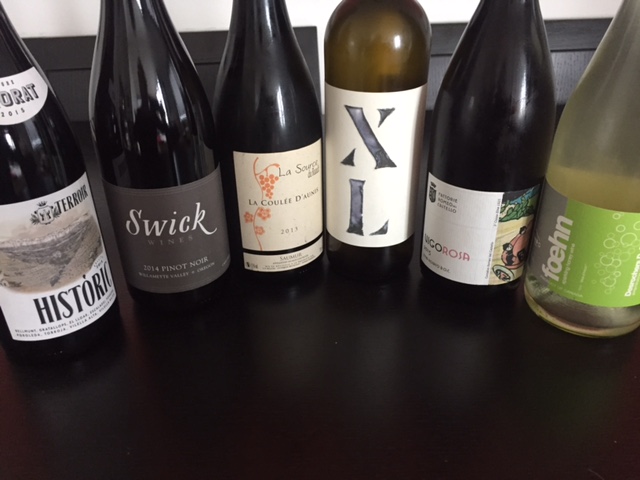
I use the same headline every year for my Thanksgiving post.
And every year there are more quality natural wines, from more diverse places, made by producers I’ve never drank before, showing new innovations and at better prices.
There has simply never been a better time in history to be alive and be a lover of wine. We are so very lucky in this respect.
This year with the help of my good friends Ariana from Chambers Street Wines and Christy from Frankly Wines, I think I nailed it.
Truly outstanding wines from Oregon, Quebec, France, Sicily and Spain. With a splash of mead thrown in.
Here’s the selection:
Terroir Historic (Terroir Al Límit) 2015 Priorat Negre ($28.99)
The crowd favorite red this holiday.
Dominik Huber is a truly talented German winemaker making restrained natural reds and whites in the Priorat, in Spain.
Much less ripe that you’d expect, significantly reduced alcohol and making not a wine of place, but a wine of region. This bottle is a blend from a scattering of organic plots with telltale llicorella clay and alluvial soils of the Priorat.
Tightly wound acids, brambly herbal berries. As Ariana Rolich put it well, ‘a Priorat for minimalists’.
To me the bottle simply says Drink Me now!
Partida Creus 2015 Catalunya Massís de Bonastre Xarello ($29.99)
This was the crowd favorite white. Basically vanished in a moment.
We know the grape Xarello from Spanish Cavas, but was new2me as a still wine.
This is simply a head-nodding beautiful bottle–mineral rich, bright, citrus, nteresting and juicy at the same time.
This one is naturally a bit wild, no added SO2, and six months on the lees. Some time on the skins is obvious through the grip of the tannins and bouquet.
I’m buying a magnum for the Chanukah gathering of the same group.
Buy and try this if you can find it.
Swick Wines 2014 Willamette Valley Pinot Noir ($27.99)
Joe Swick and I have spoken in depth about natural wine. He is outspoken, so very wine savvy, an uncompromising purist and 5th generation Oregonian from Portland. And need I mention, a true talent.
This bottle is a silky, textured and brambly Pinot, sourced from several cooler Willamette Valley sites (Cancilla, Medici, and Fairsing vineyards). A light touch with a satisfying palate that leaves you with berries on the mouth, savory in the nose, and just satisfying all over.
I’ve been drinking this bottle over and over since its release.
Feels just right each time.
Joe nailed it with this one.
Romeo del Castello 2015 Etna Rosato Vigorosa ($28)
I had the pleasure of meeting Rosanna Romeo and her daughter Chiara Vigo when in Etna a number of years ago.
I remember well their story of how the eruption of Mt. Etna in 1981 reduce 60 hectares of vines to 14 and left huge lava beds on their property.
This wine speaks to me of my love of Etna and my pining to return.
That unique taste that even in a rose is vibrant and savory, bright and acidic with a crisp finish and a spice to the aftertaste that simply won’t end.
Delicious bottle that was a perfect complement to the others at the table. I kept this one near to me the entire meal.
Source du Ruault 2013 Saumur Blanc “La Coulee d’ Aunis” ($17)
I knew this wine the least prior to drinking it. Quite a discovery.
Comes from a tiny one-hectare parcel of Chenin Blanc of almost entirely Turounien Limestone in the Loire Valley.
Perfect pre-meal, hanging around nibbling while cooking and chatting. It is lean, mineral with a silky suppleness to it that that drew me in immediately.
A bit too austere for the group, but I grabbed and nursed this one myself.
A discovery and a huge bargain at $17.
I have another one in the fridge for for some saw goat cheese I picked up at the market today.
Desrochers–Foehn Ferme Apicole Honey Wine ($37)
This is a completely natural Pet Nat mead from Northern Quebec.
Unfiltered. Unfined. No added SO2 with the yeasts cultivated from the pollens collected from the same bees that brought in the honey for this bottle.
I met the winemaker and apiarist at my panel at the Raw Fair a few weeks ago and tracked this bottle down.
As intriguing as it is delicious. Clearly not a wine made from grapes and as a beekeeper years ago, I could taste the honey in the aftertaste though it is completely dry and magically satisfying.
Super natural in every way. Twelve months on the lees, non dosage, nothing added.
Not only does this winemaker have real talent but he is certainly part of a new generation that will I am certain redefine what natural means to all of us.
Try this or the other wines linked to in the post of my panel.
I guarantee you will not be disappointed.
To close
Been a while since I threw together a post on what I’ve been drinking, rather than spit out bottle pics on Instagram
This was more fun and more useful.
I hope you enjoyed it. I am certain you will enjoy the wine!

Few things can satisfy, connect and inspire, yet remain as inexplicable, as a bottle of wine.
Few things carry with them such an encyclopedia of scientific knowledge that is invariably trumped by the simple power of nature’s almanac.
And for all of the things we love and write about, we are always a bit speechless to communicate the nuance of how a bottle of wine, uniquely special with all its details, is really only about our experience of it.
This strikes home when you have one of those serendipitous wine experiences that open up a stream of connected remembrances.
The other evening, this bottle of Grillo was the Proustian trigger that kicked this off.
I was at an impromptu family gathering at Taboon on 10th Ave in Hells Kitchen. Last minute call to celebrate a birthday.
Mediterranean food was piled high on the table. Plates of hummus, bowls of salsa, chopped salads, Baba Ganoush, Tabouli, grilled Octopus, Tuna, tomatoes, squash and pita to die for.
The big aha was discovering this almost-never-seen-in-New York bottle of Grillo from Nino Barraco, an obscure and quite wonderful natural winemaker,
I know this bottle well as five years ago this September, I had visited the winemaker with a group of friends and remember the jolting ride down a long, bumpy and soggy road to his vineyard where the salt marshes outside of Marsala, Sicily touch the steep cliffs above the sea.
There was literally nothing there but the Mediterranean in front of you, breezes rolling cross the sea from Africa and windswept untrellised Grillo vines everywhere. Unplanted almost nowhere else. Indigenous to this part of Sicily but still a rarity.
The group of us (see pic in this post) were hanging around a makeshift shack with Nino, the winemaker, in the warm afternoon Sicilian sun, drinking the very first vintage of Vignammare, 100% Grillo, grown in the tiny vineyard where we stood.
He laid out the feast on a wood plank along with fresh sea urchin and shrimp that the his family had harvested for us that morning.
Picture of a truly joyous and perfect day.
The sea, the grapes, the purity of fermented juice made with such passion and intent. As natural and non-interventionist as can be– organic, spontaneous fermentation. Unfiltered, unclarified, unsulphured.
And very special to me in retrospect, as this was still an early taste of skin-fermented white wine—somewhat new to me then, an obsession to me now–adding the minerality of the soil, the salt of the sea, the bouquet of the marsh and the bite on the palate as a pinch to memorialize all this together.
I shared this story with the table in the very noisy corner of the restaurant, heads shook with appreciation as they emptied glass after glass, after bottle.
I had them look at the richly golden color of the wine, held up against the candle light, appreciating that this was white wine, made like red.
They listened to my over zealous spin on why skin is the human touch of winemaking, where people meet the true depth of place, and somehow, it becomes the epitome of connection, perfect as the fingerprint of time, place, people, weather under the overarching shades of our own thoughts that color everything we do.
They literally drank it in.
My enthusiastic story of Marsala and my community of blogger friends by the sea wedded to this gathering of family in Hell’s Kitchen on a steamy, raucous and joyous New York evening.
This is the good stuff of wine and life to me.
Proust may have had his madeleine to spur a long and meditative tale.
We had our bottle of Grillo to celebrate the evening and ourselves.
This is my idea of perfect.
_____
To experience my visit to Marsala, post here.

“The primary nutrient in life is joy.”
This is Stefano Bellotti, winemaker at Cascina Delgi Ulivi in Chianti speaking directly from his heart—to my own.
From the moment Stefano comes on frame in Jonathan Nossiter’s documentary, Natural Resistance, I was smitten. Seriously.
It was like listening to the last six years of my own blogging on natural wines, the endless arguments with others about what it means, encapsulated into a lazy afternoon’s conversation of why he and many others do what they do.
Why I and thousands of wine lovers and bloggers are changing the world a little bit at a time by redefining what food and wine is to our lives.
I knew of Jonathon’s work slightly but didn’t know him personally nor much about the film prior.
I need to thank David Lillie and Arnaud Tronche, the co-owners of Racines and hosts for the event for the invite and encouragement to attend. This small gathering for movie and a dinner with people who not only love natural wine as writers and geeks, but are responsible as restaurant and wine shop owners, as importers and distributors, as somms, for getting the best and most interesting of these wines in front of the public.
I seriously loved this film.
With its hand-held shaky noirishness, with its quirky juxtapositions of obscure images, this movie is—yes, I need to say this—about a love of what nature has given us. About following your heart, not ideology. How the bravest amongst us invoke the very core of tradition to innovate, not to follow.
I understand Italian not at all, yet I forgot I was reading subtitles, forgot that my chair was bumping the portable projector repeatedly. I just felt like I was at home in this conversation.
I kept thinking about the folksiness’ and profundity of Whitman and Hart Crane. I kept nodding my head like a student listening to this farmer talking, creating concrete poetry out of his land and wine.
The movie, while a documentary, was so sun drenched, so lazily paced as the winemakers walked  through their vineyards. So crisp when Stefano held up the lively soil of his vineyard in one hand and contrasted it to the calcified clay of his neighbors in the other. So personal as they drank wine with their friends, hugged their children, played with their pets, that you forget—these individuals are considered radicals, almost subversive, by the Italian wine industry.
through their vineyards. So crisp when Stefano held up the lively soil of his vineyard in one hand and contrasted it to the calcified clay of his neighbors in the other. So personal as they drank wine with their friends, hugged their children, played with their pets, that you forget—these individuals are considered radicals, almost subversive, by the Italian wine industry.
Yes, revolutionaries created by the stupid rigidity of the DOC systems under which they worked.
The ‘resistance’ part of ‘natural resistance’ almost gets lost unless you know the language or the back-story. How these intelligent and exuberant people were being castigated by the Italian DOC system. Having their wines banned from supermarket shelves, and fined possibly to the point of bankruptcy because they eschew, just refuse to use, chemicals or supplements, and just make wine in their own raw, natural way.
You need to do a double take honestly that these winemaker are being made revolutionaries by the wine establishment itself. Rebels who believe that there is no social history without agriculture and that to change agriculture is to change culture and the world.
The rub is that these winemakers are not defining themselves by what they are not, not against, but for something.
They believe that the DOC should, by its definition, be helpful, but is a lie. A caretaker of something that is simply not representative of the land, the place, the taste—their lives there.
During the Q & A with Jonathon, I got the sense that he believes that the world is on the brink of ecological disaster if change doesn’t happen. Agriculture subsumed by industrialized techniques and taste that carries with it a variant of cultural suicide.
Maybe it was the inebriation of the words, the buzz of the wine I was drinking and the conversations with friends that make me take the opposite view.
Maybe this example in Italy is an extreme. Or maybe I am hopelessly naïve and optimistic.
To me, change is definitely happening.
More and more agricultural products are being made with astounding quality. More and more importers are finding them and bringing them to market. And with community and network connections, there is an economy being created that will be supportive, even if the national systems themselves are not.
And just as important, there is a rising market of people who simply do care.
I seriously recommend this film.
If you are thoughtful about the relationship of agriculture to culture. Of natural techniques in winemaking to taste. If you believe that individuals collectively impact global change.
It’s a little film with a subtle and, I think, well-placed kick. There is something special and true here.
Congrats to Jonathan Nossiter for creating such a great film and for giving us all such a fine and inspiring evening.
I felt compelled to pass it along.

Jonathan Nossiter, Eben Lillie, Chris Struck
____________
Thanks to Chris Struck for the photos I appropriated from his Facebook page.

Most people head to Mexico and drink Mojitas.
We mixed up a few, but for our annual family Spring Break in Tulum, it’s about wine and the natural best at that.
Tulum is all about being in the zone. Wonderful, refreshing and not-your-standard fare is the rule.
The setting:
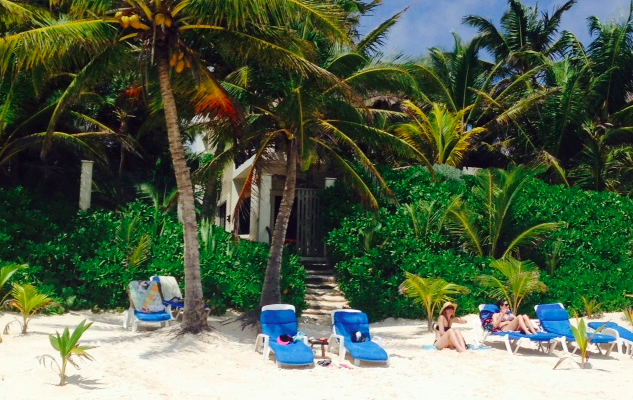 Hot and humid to the max. Hammocks under the palms. Fish and more fish on the grill. Tacos of every sort. Cerviche and guacamole every day.
Hot and humid to the max. Hammocks under the palms. Fish and more fish on the grill. Tacos of every sort. Cerviche and guacamole every day.
Basically anything you can wrap in a banana leave and put in grilled flatbread.
The wine:
 Interesting is the rule. Delicious is the grade.
Interesting is the rule. Delicious is the grade.
This year we nailed it. The most diverse and varied, the most economical and the most natural.
 Best twelve beach pack ever.
Best twelve beach pack ever.
I’ll recap with an eye towards choices over time. They are all winners.
–>Three choices from the Jura
Evelyne and Pascal Clairet from Domaine de la Tournelle in Arbois stole the show with their 2010 Terre de Gryphées Chardonnay ($27). Those who say that the Jura is an acquired taste are just plain wrong.
This chard is as unique and terroir-expressive as it is delicious. Wine geek or no, this is a head nodder with undeniable satisfaction.
Second year running on the Poulsard side was Ludwig Bindernagel’s 2010 Les Chais du Vieux Bourg ($34). This German newcomer to the Jura just nails it. Light with a rich body, layered and lovely, a larger than life bouquet for such a delicate wine.
Puffeney made the cut this trip. His 2011 Les Berangeres Trousseau ($35) was the third Jura bottle. The family loved it. I found it a bit austere with a hard edge but quaffable nonetheless.
–>A touch of Sicily and anfora with Giusto Occhipinti’s COS Pithos
COS makes the trek yearly. The 2012 COS Pithos IGT ($31) Cerrasuolo Frappato/Nero D’Avola blend was as expected–delicious and unassuming.
Lightly chilled, delicate and satisfying are its hallmarks. Giusto is the first winemaker I ever tasted that fermented in Anfora and a personal hero and friend. This wine nails it in just about every category
–>Gruner from Nikolaihof is as good as it gets
I love this vineyard. Natural. Bio-D. Ancient. As crisp and unique a Gruner Veltliner as you can find. This year (the third appearance of Nikolaihof) we switched to the 2012 Hefeabzug Gruner Veltliner ($25). A winner.
–>More bubbles make the cut
Bubbles are an occasion in their own right. Two bottles made the trip with us.
The first Cava to cross the border was the 2011 Raventos i Blanc de Nit Rose Brut Conca Del Riu Anoia ($22). Elegant, smokey citrus from the Monastrell grape. We had it with a breakfast/brunch on the first morning. Yum!
The Filaine NV Brut ler Cru Damery Cuvee Speciale ($49) was the priciest of the bottles and a special treat. Creamy and classical. A Pinot Noir/ Chardonnay/ Pinot Meunier blend of 2009 and 2010 grapes was oh so ripe and finely moused and bubbly crisp. This was brought for a birthday and it crushed expectations.
–>A bit of Alpine Savoie at the Mexican seaside
I’ve fallen hard to this region, the producers and varietals. I could have brought a half case of just these whites.
I tasted with Gonon recently and his 2012 Vin de France Chasselas Vieilles Vignes ($25) is well—a dream. Subtle and herbal with smacks of fruit. I so love this bottle. So did everyone.
I’m a long-term Belluard fan. His 2012 Grandes Jorasses Altesse ($34) is fresh, mineral, crips, light and delicious. I had sent this bottle as presents earlier in the year. It’s a family tradition already.
Next to the Jura–in fact Savoie is Jura adjacent–this is fast becoming my favorite region.
–>New world naturalists make the trip
A first for this vacations–an Oregon Pinot Noir and a California Grenache/Mourvedre blend.
I tasted the 2009 Montebruno Eola-Amity Hills Pinot Noir ($25) with the winemaker Joe Pedicini earlier in the year. Bio-D, a light effervescence and deep flavor are its traits. Served lightly chilled in water glasses on the terrace overlooking the sea was a crowd pleaser.
Hank Beckmyer from La Clarine Farms is a favorite of mine for the brilliance and ease of his wines. A Grenache and Morvedre blend at km 9.2 in Tulum? I say, hell yes!
The 2012 Sierra Josephine & Mariposa ($25) is a beautifully balanced and structured, tannin-laden bottle. I did chill it slightly and with some home made Quesadillas and Cerviche, it was a killer.
Not a hint of sulfur added in these. Not a touch of funk. Freaking lovely natural wines!
–>Wrapping up with a Cotes de Provence Rose
From the selections of my friend David Lillie was a Les Fouques 2012 Aubigue Rose ($13!).
This blend of Cinsault, Grenache, Syrah, Cabernet Sauvignon, is almost pale white, shot with pepper, light on the palate, dreamy on the nose and perfect on the hammock.
Small producers all.
These wines are very small productions and go in and out of stock. Some are available at Chambers Street Wines and online through other small specialty shops. Shop the producer if not the vintage.
I will wager a free bottle on me for long-term readers that these will delight.
A thank you to my friends Sophie Barrett and Ariana Rolich of Chambers Street Wines for making the process of choosing almost equal to the drinking.
Some photos to capture the joy of this place along with the wine.
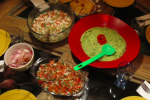 Daily feast.
Daily feast.
 Playtime in between resting and sipping.
Playtime in between resting and sipping.
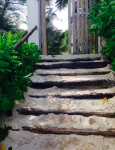 Hammock is up and to the right.
Hammock is up and to the right.
 Marsala sits with its back towards Africa, shorelined against the Mediterranean on the northwesternmost tip of Sicily.
Marsala sits with its back towards Africa, shorelined against the Mediterranean on the northwesternmost tip of Sicily.
Magical as a metaphor for a place so ancient, and a wine craft with such a long tail of lore. Yet when you visit your local wine shop, search the web, the intrigue evaporates in a flash.
You are left with an image of boatloads of sweet dreck, commoditized cooking wine, and Marsala itself at the very bottom of the list of fortified wines.
Few of the most wine enthused know that the traditional regional wine, perpetuum, is still being made. Nor that unique and delicious natural expressions of the Grillo and Zibibbo grapes are available, albeit impossible to find.
Marsala as a region, as a brand, as a wine type is truly a mess in the wine market’s eyes. But well worth brushing off and reimagining.
I did so with a visit recently. Two winemakers, Renato De Bartoli and Antonino Barraco, were at the top of my discovery list, hinting at what Marsala is really about.
Marco De Bartoli
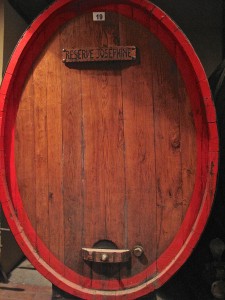 This huge cask is in the ‘perpetuum’ room, a 200-year old cellar on the vineyard where the De Bartoli family has been growing grapes for 6 generations. Marco, the patriarch and regional wine revivalist, started the winery that holds his name in 1978, fermenting a back-to-the-past-future of truly delicious and place-unique natural wines.
This huge cask is in the ‘perpetuum’ room, a 200-year old cellar on the vineyard where the De Bartoli family has been growing grapes for 6 generations. Marco, the patriarch and regional wine revivalist, started the winery that holds his name in 1978, fermenting a back-to-the-past-future of truly delicious and place-unique natural wines.
In these immense casks, Grillo, the chameleon-like indigenous grape of the region, is being transformed into Vecchio Samperi, the De Bartoli family perpetuum wine. An ancient wine that predates the creation of fortified Marsala in 1796, patiently aged using the Solera method, a blending style where new vintages of Grillo are added to old, year after year, decade after decade.
Take organic Grillo grapes, add the deepening power of time, natural oxidation and concentration. Open the cellar to atmospheric humidity, an air born terroir from Sicilian winds—the Scirocco from Africa, warm and wafting from the Southeast, the Tremonton, cooling from the North
What you get is Vecchio Samperi, 17-18% alcohol, unnervingly compelling and delicately rich on the palate. A ticket to taste hundreds of years old.
 Renato De Bartoli, one of Marco’s three sons is the winemaker of the Samperi vineyard. He told us tales of the wine, this place, and Grillo with unbridled exuberance, a palpable disdain for what Marsala has become in the world’s eyes and a resolute focus on recreating the best of this regions tradition for today’s market.
Renato De Bartoli, one of Marco’s three sons is the winemaker of the Samperi vineyard. He told us tales of the wine, this place, and Grillo with unbridled exuberance, a palpable disdain for what Marsala has become in the world’s eyes and a resolute focus on recreating the best of this regions tradition for today’s market.
I liked him instantly—even more so after we spent hours feasting on local fare, tasting bottles of Vecchio Samperi equal to my age, samples of Grappoli del Grillo, back to the mid 1900s, and Bukkuram, made from the Zibibbo grape, grown on their vineyards on Island of Pantelleria.
An astounding (and very long) evening. A deep stride into De Bartoli’s Marsala–in taste, in authenticity, steeped in the old and focused on recreating something uniquely their own.
Antonino Barraco
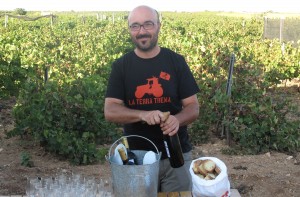
This is the infectious smile of Antonino (Nino) Barraco, natural winemaker, holding court under the Sicilian sun, pouring Grillo, serving fresh caught shrimp and sea urchins at his tiny (8,000 sq. meters) Vignammare Vineyard.
We are in Riserva di Capo Feto nature preserve, a salt marsh with a dirt road, heading due west to the ocean. At the very end, ocean smack there, the Scirocco and the Tramontana winds in full force, is the vineyard.
Not a cellar in sight, just sea, sand, salt….and Grillo grapes.
Nino comes to winemaking through his father, a grape grower, and we are drinking their first vintage of Vignammare, 100% Grillo, grown where we stand. As natural and non-interventionist as can be– organic, spontaneous fermentation with long skin macerations. Unfiltered, unclarified and no added sulphur.
This is wine born of the love of land, the taste of the sea, and a trust in nature and the winemaker. This is bottled fruit, time, place and natural intent.
Salty to the tongue, a touch of iodine in the palate, spicy somehow, ocean fresh and just a pleasing clarity of taste with distinct minerality.
Perfect with the fresh sea urchins, the hot sun, feet in the sandy loam, surrounded by friends in a foreign place. Perfect just about anywhere really.
This is the Marsala I discovered.
I fell in love (hard!) with Grillo, and these winemaker’s expressions of this grape. But I never had the chance to spend much time with Zibibbo. Or Perricone, the local red variety, especially interesting in the care of Marilena Barbera of Cantine Barbera in Menfi.
There is just something very special here that I barely tapped.
The distinctive quality of the indigenous grapes. The hot sun tempered by a deep loamy limestone soil. The sea itself as important as the bordering lands. And the crisscrossing of winds, whipping up something unique in each and every glass.
These wines are really hard to locate. Marco De Bartoli is imported into New York by Louis Dressner, but near impossible to find with the exception of a few at Chambers Street Wines. Baracco is without distribution here at the moment.
Consider asking for wines from these producers when you are in a wine friendly place. Your local shop or wine bar, or when chatting with your favorite sommelier. With some luck, someone will eventually say, ‘Yes!’, we have it.
The pleasure will be all yours. I guarantee it.
_______________
Big thanks to Regione Siciliana – Istituto Regionale Vini e Oli, in collaboration with Fermenti Digitali / Proposta who sponsored me on this trip.
For those interested in excellent posts by my fellow wine bloggers, check them out here.
 What a really fun time this was!
What a really fun time this was!



















